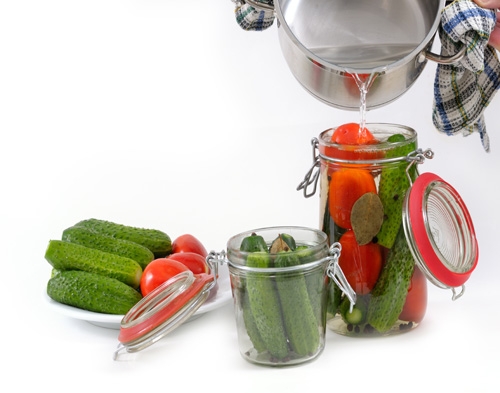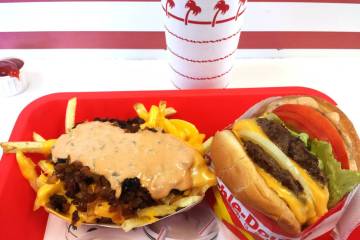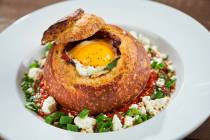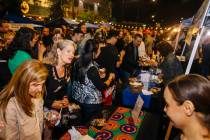Nevada Cooperative Extension offers master food preserver class
Yeah, you know about Grandma canning fruits and pickles, and maybe relishes, preserves and conserves. But have you ever thought about doing it yourself -- or even "putting up" meats or fish?
More and more people are, said Carolyn Washburn, an associate professor at Utah State University who'll teach a master preserver class later this month at the University of Nevada Cooperative Extension. Similar to the master gardener program, master preservers receive 30 hours of education in home food preservation and are certified to teach others.
"They can't give people certificates, but they can teach others to can," she said.
Which is a good thing because, Washburn said, interest in canning in general has increased exponentially. When she moved to St. George, Utah, 10 years ago and started to offer a master preserver class, few people were interested, she noted. Now, "I get a call every week to teach a class. With the downturn in the economy, it's amazing how many people want to go back and learn those old skills. Everybody's getting out their mother's and their grandmother's old canners and learning to do it correctly."
And learning is key. Canning may seem quaint, old-fashioned and not very high-tech, but food safety is a serious subject, and continuing research in food preservation has led to a series of changes in recommendations for canning safely. So if you can't make the class, don't assume your mother, grandmother or Aunt Hattie wasn't dancing with death -- or at least a real good case of botulism poisoning, which, yes, can be fatal -- when she canned those carrots.
"Home-canning guidelines can be quite different from what they were 20 years ago," Washburn said.
Washburn is certified by the U.S. Department of Agriculture, which employs her to teach food preservation. The definitive source of canning research, she said, is the University of Georgia, which released new guidelines in December 2009. The website for the National Center for Home Food Preservation, which offers free information and an online course, is www.UGA.edu/nchfp (or call Nevada Cooperative Extension for information at 222-3130).
But there are a few general guidelines.
■ Water-bath canners -- that would be the big pot with a rack and a lid -- can be used only for jams, jellies, fruits and high-acid foods such as tomatoes. And pay attention to processing times, which can vary with the food.
■ Pressure canners are needed for just about anything else -- low-acid foods including vegetables, meats and soups. But don't assume that your mother's old pressure canner is no good. "Some of those old ones will last forever and just need a new gauge," Washburn said.
■ Jars and rings can be reused, but lids cannot. Therefore, if you get a gift of canned food, canners' etiquette dictates that you return the jar and ring when the food is gone.
But back to that canned meat, which seems foreign to some novice canners. Why do people like to do it?
"Because you can can a pound of chicken breast for just a little over $1; what everybody does is wait for it to go on sale," Washburn said. "It will cost you $7 to buy that much at the supermarket."
Yeah, but what can you do with canned chicken?
"It's great in enchiladas or fajitas, different salads, chicken-cashew sandwiches, casseroles ..." she said.
Many people, Washburn added, haul out their canners during hunting season.
"A lot of people want to be able to can their own venison, fish and wild game," she said. "It really is very easy to do."
Or fish.
"It can be any kind of fish," she said, although "your fatty fish like mackerel probably don't can as well as trout or salmon. You can even can shrimp."
Or about any other kind of food. Dennis Johnson, who said he and his wife, Mary, have been canning food for 40 years, are members of the Church of Jesus Christ of Latter-day Saints, which instructs its members to keep emergency supplies of food. To that end, the church has a cannery in Las Vegas, where members use actual cans -- No. 10, which hold about three quarts.
"It could be you're out of work," he said. "Now you've got the food to support yourself. We're seeing some difficult times right now where food prices are skyrocketing. It sort of offsets some of that."
Johnson said members are given information about shelf life of various foods.
"What we try to teach the people is don't just get the stuff and put it on the shelf, but try to rotate it and use it," he said.
Food reaching the end of its shelf life may be donated to food banks or for disaster relief, he said (as well as medical supplies and items such as blankets).
"Within 24 hours, a container or several can be sent out," he said. "We're usually well ahead of any nation's ability to provide." So far, he said, church members nationwide have donated 70,000 tons of food for Japanese disaster relief.
At home, Johnson said, he and his wife dehydrate a lot of food, and use jars to can "just about any kind of fruits," plus red meat and chicken.
Yvonne Hardy, who took the March class, said she'd done a little canning with friends in the past. She became more interested lately, she added, because she's an LDS member and "it's something I'd like to do properly." She cans mostly fruit, noting that strawberry jam makes a nice gift.
Plus, "if I buy in bulk, like produce, it doesn't spoil, because I tend to waste a lot," she said. "This is a nice way of preserving the food and having it last."
Marilyn Yamamoto, who also took the class, said she had done a little canning with older relatives, and that she was glad to learn the updated USDA guidelines. Since she's a master gardener and currently has 1½ acres of land and just put in 70 fruit trees, she figures she'll be doing a lot of canning in the future.
"The main thing is because I'm growing so much," she said. "It's wise to be learning how to can more. The great thing is being able to can juice. I wasn't even aware of that."
So what advantages does canning offer over freezing, which may be the most common form of food preservation? Well, for one thing, there are some foods that don't lend themselves to freezing because cell walls break down and the food ends up mushy.
The best thing about canning, Yamamoto said, is "the longevity -- of keeping fresh. I'm going to say 'fresh' vegetables and meats and fruits."
Her advice to novices?
I would say take a canning class," she said. "The great thing is going through this master preserving class and being certified. All of us who attended need to go out to the community and put on more classes. That's going to be the fun thing."
Contact reporter Heidi Knapp Rinella at hrinella@reviewjournal.com or 702-383-0474.
NEXT CLASS
The next master food preserver training (which covers dehydration and freezing as well as canning) is scheduled from 8 a.m. to 5 p.m. April 28 and 29 at the University of Nevada Cooperative Extension Lifelong Learning Center, 8050 Paradise Road (near Windmill Lane). It's a hands-on class, so only 24 registrations will be accepted. The fee is $100 for those who agree to teach 40 hours of home food preservation in the community during the next year, $150 for those who don't. To register or for more information, call 257-5555.






















